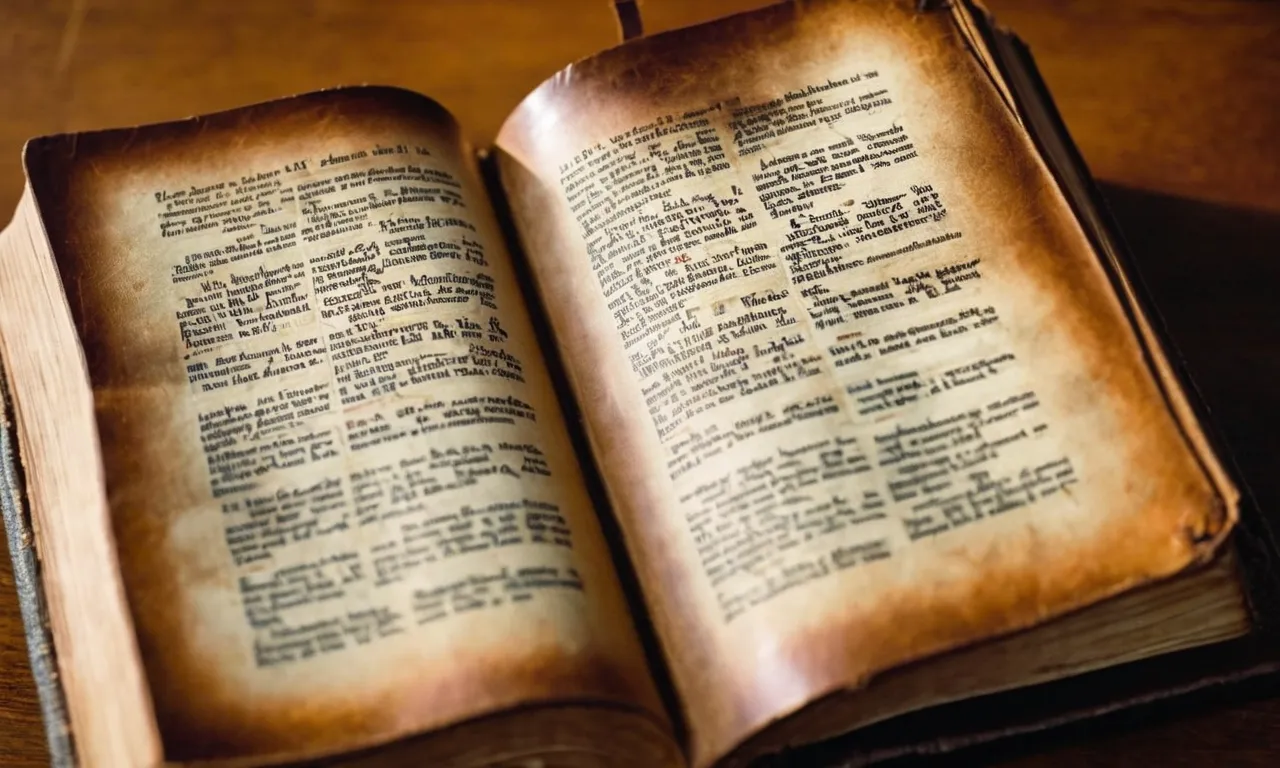What Books Did John Write In The Bible?
The apostle John, one of Jesus’s twelve disciples, is traditionally credited as the author of five New Testament books. These include the gospel that bears his name (the Gospel of John), three letters or epistles (1, 2 and 3 John), and the Book of Revelation.
If you’re short on time, here’s a quick answer to your question: The apostle John wrote the Gospel of John, 1 John, 2 John, 3 John, and Revelation.
The Gospel of John
John’s Authorship
The Gospel of John emphasizes Jesus’ divine nature and eternal existence. Most biblical scholars believe the author is the apostle John, the son of Zebedee and one of Jesus’ 12 disciples. John’s authorship is supported by early church fathers like Irenaeus (c. 130 – c. 202 AD) who wrote that the apostle John wrote the Gospel while living in Ephesus in Asia Minor.
The similarity of writing style also suggests common authorship between the Gospel and John’s letters in the New Testament.
Purpose and Themes
John stated his purpose for writing the Gospel in John 20:31 – “…that you may believe that Jesus is the Christ, the Son of God, and that by believing you may have life in his name.” Key themes highlighted in John include Jesus as the divine Word, Jesus as the Lamb of God and Son of God, the importance of believing in Christ, and everlasting life for believers.
The gospel has a strong theological tone as compared to the more narrative-based synoptic gospels.
Key Features and Contents
Some key features of the Gospel of John include:
- Contains many metaphorical statements by Jesus, like “I am the light of the world” (John 8:12)
- Records 7 miracle signs to demonstrate Jesus’ divinity
- Includes expanded dialogues of Jesus and his debates with the Pharisees
- Highlights encounters like the Samaritan woman at the well (John 4)
- Passion narrative covers about 1/3 of the book (Chapters 12-21)
In terms of contents, the Book of John covers Jesus’ ministry including calling his disciples, conversations with Nicodemus and the Samaritan woman at the well, healing miracles, feeding of the 5000, Jesus’ betrayal and arrest, his trial before Pilate, crucifixion, burial and resurrection appearances.
1 John
Purpose and Themes
The First Epistle of John, often referred to simply as First John, is the first of the Johannine epistles of the New Testament, and is attributed to John the Evangelist. The purpose of this letter seems to be to combat certain false teachings concerning the identity of Christ that denied either His humanity or His deity.
John emphasized the reality of the incarnation, which affirmed that Jesus Christ came in the flesh.
Some of the major themes include:
- Love – John stressed the importance of love, which should characterize the life of a genuine believer. God is love, so His children also should reflect His love.
- Light versus darkness – Light represents truth and righteousness, darkness represents deceit and sin. The children of light will reflect God’s light in their actions.
- Eternal life – John assured believers of eternal life in Christ. The key is having the right understanding of and faith in Jesus.
By providing reassurance of salvation in Christ, John sought to encourage believers in their faith and protect them against seduction by false teachings.
Key Contents and Outline
1 John contains 5 chapters:
- Prologue (1:1-4)
- God Is Light (1:5-2:27)
- Children of God Love One Another (2:28-3:24)
- Test the Spirits (4:1-21)
- Faith in the Incarnate Son of God (5:1-21)
An outline of the book is as follows:
- Prologue (1:1-4) – John introduces the major theme of the incarnation of Jesus Christ and declares the purpose of writing his letter.
- God Is Light (1:5-2:27)
- Conditions for Fellowship with God (1:5-2:2) – To have fellowship with God, believers must walk in His light and confess their sins.
- Tests of True Knowledge of God (2:3-27) – True knowledge of God is evidenced by obedience to His commands, love for others, and rejection of worldliness.
- Children of God Love One Another (2:28-3:24)
- Children of God Abide in Christ (2:28-3:3) – God’s children practice righteousness, love other Christians, and look forward to Christ’s return.
- Love One Another (3:4-24) – True children of God demonstrate His love. Hatred reveals spiritual death.
- Test the Spirits (4:1-21)
- Test the Spirits (4:1-6) – Many false prophets have gone out, so test their teachings against sound doctrine.
- God Is Love (4:7-21) – Christians who love one another demonstrate that they are born of God and know Him.
- Faith in the Incarnate Son of God (5:1-21)
- Faith in Christ Overcomes the World (5:1-5) – Through faith, believers can overcome the evil in the world.
- Witnesses of Jesus Christ (5:6-12) – The Spirit, water, and blood testify that Jesus is the Son of God.
- Christian Certainties (5:13-21) – John wrote to strengthen the faith of believers, assuring them of eternal life in Christ.
2 John
Summary of Contents
Here is a brief overview of the contents in 2 John:
- John opens with a greeting, expressing his love for the readers who are firm in the truth (verses 1-3)
- He rejoices at finding some of the children in the church walking in the truth (verse 4)
- John reminds them to love one another according to God’s commandments (verses 5-6)
- He warns about deceivers who do not acknowledge Jesus Christ coming in the flesh (verses 7-9)
- John advises not to receive these false teachers or wish them well (verses 10-11)
- He hopes to visit them soon and share more face to face rather than writing (verses 12-13)
Purpose
“To the chosen lady and her children, whom I love in the truth…”
From this opening, we see that John is writing to commend a specific woman and her children for remaining faithful to the truth. There are a few key purposes woven throughout this short epistle:
- To Express John’s Love and Joy: Multiple times John expresses his love for this woman and her children and that he rejoiced greatly to find some of her children walking in the truth (verses 1, 4).
- To Remind Them to Love: John encourages the readers to continue loving one another according to God’s commandments (verses 5-6). This reflects one of John’s major themes of brotherly love seen in his other writings as well.
- To Warn Against False Teachers: A significant portion of 2 John is focused on warning against deceivers who do not acknowledge Jesus Christ or that He came in the flesh (verses 7-11). John advises believers to avoid supporting these false teachers in any way.
- To Express Desire to Visit: In his closing remarks, John shares his hope to come visit them soon to talk face to face. This indicates his ongoing pastoral concern and care for this church (verses 12-13).
3 John
Summary of Contents
The third epistle of John is one of the shortest books of the Bible, containing only 15 verses. However, it offers valuable insights into the early Christian church. The letter was written by the apostle John to his friend Gaius, commending him for his hospitality and faithfulness.
John encourages Gaius to continue supporting fellow believers, especially the traveling teachers spreading the gospel. He also warns against Diotrephes, who loves to put himself first and refuses to welcome these teachers.
Overall, 3 John focuses on the importance of living in truth, walking in Christ’s commands, and showing sacrificial love within the church.
Purpose
There were several key purposes behind John’s writing of 3 John:
- To commend Gaius for his spiritual leadership and generosity in supporting those spreading the gospel
- To encourage Gaius to continue providing hospitality to traveling teachers even though Diotrephes opposed it
- To warn against false teachers like Diotrephes who did not walk in truth and tried to hinder the work of genuine ministers
- To urge Gaius and the church to continue imitating what is good rather than what is evil
- To highlight the blessing of walking in truth, as Christ’s commands teach
Revelation
Evidence of John’s Authorship
The Book of Revelation directly states that it was written by someone named John (Revelation 1:1,4,9; 22:8). Early Christian tradition uniformly affirmed that this John was John the Apostle, one of the twelve disciples of Jesus.
Some key evidence that the John who wrote Revelation was the same John who wrote the fourth gospel includes:
- Similarities in language and style. For example, both books repeatedly refer to Jesus as the Lamb.
- The authoritative tone. The writer of Revelation identifies himself as a prophet (Revelation 1:3) and expects his words to be heeded as God’s instructions.
- Early church father testimony. Church leaders like Justin Martyr, Irenaeus, Clement of Alexandria, and others all affirmed John the Apostle as the author.
Most modern scholars believe the same author wrote both Revelation and the Gospel of John. The precise identification of this John, however, remains debated. Many believe the stylistic differences between Revelation and John’s other writings can be accounted for by the distinct genre and circumstances under which Revelation was written.
Summary of Key Events and Symbols
The Book of Revelation is filled with vivid imagery and symbolism that can seem confusing at first. Here is a quick overview of major events and symbols:
- Letters to seven churches – Messages from Jesus to seven churches in Asia Minor, containing praise, warnings, and calls to repentance (Chapters 2-3).
- God on the throne – A vision of the glory and power of God in heaven (Chapters 4-5).
- Seven seals – As each seal on a scroll is opened, a new judgment or calamity befalls the earth (Chapter 6).
- Seven trumpets – Seven angels blow trumpets that unleash plagues and disasters (Chapters 8-9).
- The woman, child and dragon – A pregnant woman represents Israel; the child is the Messiah; the dragon is Satan (Chapter 12).
- The beasts – A seven-headed beast from the sea and a beast from the earth oppress God’s people but are later defeated (Chapters 13-14).
- Seven plagues – Seven bowls of wrath are poured out on the earth, consisting of painful sores, the sea turning to blood, the sun scorching people, and more (Chapter 16).
- The fall of Babylon – A harlot named Babylon, representing paganism and human vanity, is destroyed (Chapters 17-18).
- Second coming of Christ – Jesus returns as conquering King, defeats Satan, and ushers in the fullness of God’s kingdom (Chapter 19-22).
This list provides just a sample of Revelation’s key symbolic visions. Recognizing how these images draw heavily from Old Testament prophetic books helps unlock Revelation’s meaning.
Conclusion
In summary, Christian tradition credits John the apostle as the author of five New Testament books – the Gospel of John, three letters known as 1, 2 and 3 John, and the prophetic Book of Revelation. While some scholars debate John’s actual authorship of these books, most acknowledge his influence in shaping their key theological themes and messages for the early church and Christians today.








